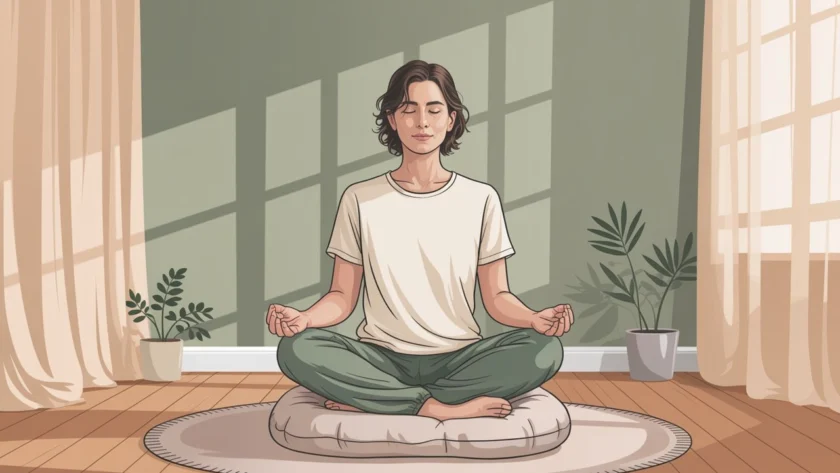I’ll never forget the first time my therapist suggested I try progressive muscle relaxation for my anxiety. I was sitting in her office, my shoulders practically touching my ears, my jaw clenched so tight I’d given myself a headache. “Amelia,” she said gently, “your body is holding onto all that worry. What if we taught it how to let go?”
I remember thinking it sounded too simple. How could tensing and releasing my muscles possibly touch the swirling chaos in my mind? But here’s what I’ve learned over the years: our bodies and minds are more connected than we realize. When anxiety takes hold, it doesn’t just live in our thoughts—it settles into our shoulders, our neck, our jaw, creating physical tension that actually feeds the anxiety loop. Progressive muscle relaxation became one of my most trusted tools for breaking that cycle, and I believe God designed our bodies with this remarkable capacity to find calm when we know how to access it.
What Is Progressive Muscle Relaxation?
Progressive muscle relaxation, or PMR, is a technique developed back in the 1930s that involves systematically tensing and then releasing different muscle groups throughout your body. The idea is beautifully simple: by deliberately creating tension and then letting it go, you become more aware of what relaxation actually feels like. Your body learns to recognize the difference between holding on and releasing.
I like to think of it as a conversation with your body. We spend so much time living from the neck up, especially when we’re anxious, that we forget our bodies are trying to communicate with us. PMR is like finally learning to listen.
What struck me most when I started practicing this technique was how much tension I’d been carrying without even realizing it. I thought I knew what “relaxed” felt like, but I was actually walking around with my muscles constantly braced, ready for the next threat. My body had forgotten what peace felt like.
The Mind-Body Connection and Anxiety
Here’s something I wish someone had explained to me earlier in my anxiety journey: when your muscles are tense, your brain interprets that as a signal that you’re in danger. It’s like your body is constantly telling your mind, “Stay alert! Something’s wrong!” Even when nothing is actually threatening you.
The beautiful thing is that this connection works both ways. When you deliberately relax your muscles, you’re essentially sending your brain a different message: “We’re safe. You can stand down now.” It’s not magic, but it feels pretty close to it sometimes.
In Philippians 4:6-7, Paul writes about bringing our anxious thoughts to God in prayer, and how God’s peace will guard our hearts and minds. I’ve found that PMR can be a physical form of that surrender—a way of literally releasing the grip anxiety has on our bodies while we talk to God about what’s weighing on our hearts. It’s become one of my favorite ways to pray, actually. While I’m working through the muscle groups, I’m also working through my worries with the One who can actually carry them for me.
How Progressive Muscle Relaxation Helps Anxiety
Let me share what this practice has done for me, and what I’ve seen it do for others:
It interrupts the anxiety spiral. When you’re caught in anxious thoughts, your body responds with tension, which feeds more anxious thoughts, which creates more tension. It’s exhausting. PMR breaks that cycle by giving you something concrete to focus on—something you can actually control when everything else feels out of control.
It creates awareness. Before I learned this technique, I had no idea I was clenching my jaw or hunching my shoulders all day long. PMR taught me to recognize tension as it’s happening, which means I can address it before it builds into a full-blown panic attack.
It’s portable and free. Unlike some anxiety management tools, you don’t need equipment, apps, or even a quiet space. I’ve done PMR in my car before a stressful meeting, in bed when I can’t sleep, even sitting at my desk when I feel anxiety creeping in. Your body goes with you everywhere—might as well learn to use it as a tool for peace.
It gives you evidence that you can feel better. This might be the biggest gift PMR gave me. When anxiety convinced me I’d feel terrible forever, I could practice PMR and within ten minutes feel noticeably calmer. That became proof that the anxiety was lying to me.
Preparing for Your PMR Practice
Before we walk through the actual technique, let’s talk about setting yourself up for success. I learned these tips the hard way, through plenty of trial and error.
Find your space. You don’t need a perfect meditation room with candles and soft music, but you do need somewhere you won’t be interrupted for 15-20 minutes. I started practicing in my bedroom with the door locked and a note on the door handle: “Mom needs 15 minutes. I love you. I’ll be out soon.” My kids learned to respect that boundary because they saw how much better I was afterward.
Get comfortable. You can do PMR sitting or lying down. I prefer lying on my bed or the floor with a pillow under my knees, but I’ve also done it sitting in my office chair or even in the car. Just make sure you’re not so comfortable you’ll fall asleep (unless that’s your goal—PMR is fantastic for insomnia).
Set realistic expectations. The first time you try this, it might feel weird or awkward. That’s completely normal. You’re learning a new skill, and like any skill, it takes practice. I tell people to commit to trying it daily for at least two weeks before deciding if it works for you.
Consider it an act of worship. This shift in perspective changed everything for me. Instead of seeing PMR as just another anxiety technique, I started viewing it as stewarding the body God gave me. In 1 Corinthians 6:19-20, Paul reminds us that our bodies are temples of the Holy Spirit. Taking time to release tension and invite peace into my physical body became a way of honoring that truth.
Step-by-Step Progressive Muscle Relaxation Technique
Alright, let’s walk through this together. I’m going to share the method that works best for me, starting from the feet and working up to the head. Some people prefer going the other direction—do whatever feels right for you.
Starting Position
Lie down or sit comfortably with your arms at your sides. Close your eyes if that feels comfortable, or maintain a soft gaze at a spot on the ceiling or wall. Take three slow, deep breaths—in through your nose, out through your mouth. With each exhale, let your body sink a little deeper into whatever surface is supporting you.
I often start with a simple prayer: “God, I’m bringing You my anxiety and my tension. Help me release what I’m holding onto. Teach my body what Your peace feels like.” There’s no magic formula—just an invitation for God to meet you in this moment.
Feet and Lower Legs
Focus your attention on your feet. Curl your toes downward as tight as you can, creating tension in your feet and lower legs. Hold that tension while you slowly count to five. Notice what that tension feels like—where you feel it most, how uncomfortable it is to hold on.
Now release. Let your toes relax completely. Feel the tension flowing out of your feet like water. Notice the difference between how your feet felt when they were tense and how they feel now. Take a few normal breaths while you appreciate that release.
Upper Legs
Tighten your thigh muscles by straightening your legs and pointing your toes toward your head. Squeeze those muscles as hard as you can. Hold for five seconds, really feeling that tension.
Release. Let your legs become heavy and relaxed. Feel them sinking into the bed or chair. Breathe naturally and notice the sensation of letting go.
Stomach and Lower Back
Pull your stomach in tight, as if you’re bracing for someone to punch you in the gut (not a pleasant image, I know, but it works). You’ll feel tension through your abdomen and lower back. Hold it… and release.
Let your belly be soft. This is often where I carry a lot of anxiety, so I sometimes spend an extra moment here, just breathing into my stomach and reminding myself that I don’t have to brace against the world.
Chest and Upper Back
Take a deep breath and hold it while you pull your shoulder blades together behind you, pushing your chest forward. Feel the tension across your upper back and chest. Hold for five seconds.
Exhale and release, letting your shoulders fall back into a natural position. Feel your chest soften. Sometimes I’ll whisper the word “peace” on the exhale, or “I trust You, God.”
Arms and Hands
Make tight fists with both hands and bend your arms to bring your fists toward your shoulders, tensing your biceps. You should feel tension from your hands all the way up through your upper arms. Hold it.
Release. Let your arms fall naturally to your sides or rest on your lap. Feel your fingers uncurl, your arms become heavy. I love this release—there’s something about unclenching your fists that feels like literally letting go of control.
Shoulders and Neck
Raise your shoulders up toward your ears, trying to touch them together. Hold that uncomfortable position—this is where many of us hold chronic tension. Count to five.
Drop your shoulders. Let them fall away from your ears, feeling the weight of them settling downward. Roll your head gently from side to side if that feels good. This is often where I feel the most dramatic relief.
Face and Jaw
Scrunch up your entire face—squeeze your eyes shut tight, wrinkle your nose, clench your jaw, press your tongue to the roof of your mouth. Make the most ridiculous face you can. Hold it (yes, you look silly, and that’s okay).
Release everything. Let your jaw drop slightly open, relax your tongue, smooth out your forehead. Feel your face become soft and peaceful. I didn’t realize how much tension I carried in my face until I learned to release it. Some days, this step alone can shift my entire mood.
Full Body Scan
Now that you’ve worked through each muscle group, take a moment to scan your entire body from toes to head. Notice areas that still feel tense—it’s okay if some tension remains. You can mentally return to those areas and do one more tense-release cycle, or simply breathe into them with acceptance.
Take three more deep breaths, and with each one, imagine breathing in God’s peace and breathing out whatever worry or tension remains. Psalm 46:10 says, “Be still and know that I am God.” This is that stillness—not an absence of feeling, but a presence of peace.
When you’re ready, gently open your eyes and take a moment before jumping back into your day. Notice how your body feels now compared to when you started.
Making PMR a Regular Practice
Here’s what I’ve learned about building this into daily life: consistency matters more than perfection. I don’t do a full 20-minute PMR session every single day, but I use elements of it constantly.
Morning practice: I’ll often do a quick version—just five muscle groups—right after I wake up, before I even get out of bed. It sets the tone for my day and helps me start from a place of peace instead of immediately launching into worry mode.
Midday reset: When I notice my shoulders creeping up toward my ears while I’m working, I’ll pause and do just the shoulder and neck release. It takes 30 seconds and makes a huge difference.
Bedtime routine: A full PMR practice before bed has been life-changing for my sleep. I pair it with gratitude journaling and prayer, and it’s become my favorite part of the day—a time when I consciously hand God all the things I’ve been trying to carry.
During anxiety spikes: When I feel panic rising, PMR gives me something to do. Instead of fighting the anxiety or trying to think my way out of it, I go through the muscle groups. By the time I’m done, the panic has usually peaked and started to subside.
Combining PMR with Faith Practices
One of the most powerful things I’ve discovered is layering PMR with spiritual practices. They enhance each other beautifully.
Scripture meditation: While you’re doing PMR, you can slowly repeat a verse or phrase. I love using “The Lord is my peace” or “I am held” or simply “Peace, be still.” Say it on each exhale as you release the tension.
Breath prayers: The Jesus Prayer (“Lord Jesus Christ, have mercy on me”) works wonderfully with PMR. Half on the inhale as you tense, half on the exhale as you release.
Gratitude focus: With each muscle group you release, thank God for something specific. It shifts your mind from anxiety to appreciation.
Visualization: As you release each area of tension, imagine God’s peace flowing into that part of your body like warm light. Picture it filling the spaces where anxiety used to live.
Troubleshooting Common Challenges
Let me address some things that tripped me up when I first started:
“I can’t feel the difference between tense and relaxed.” This is super common, especially if you’ve been chronically tense for a long time. Keep practicing. The awareness will develop. It took me several weeks before I really started noticing the difference.
“My mind wanders constantly.” Of course it does—that’s what anxious minds do. Don’t fight it or judge yourself. Just gently redirect your attention back to the muscle group you’re working on. Every time you notice your mind has wandered and bring it back, you’re building a skill.
“I feel more anxious when I focus on my body.” This can happen, especially if you’ve experienced trauma. Start with shorter sessions—maybe just five minutes focusing on hands and feet. You can also keep your eyes open. If it consistently increases your anxiety, talk to a therapist about whether body-based techniques are right for you right now.
“I fall asleep every time.” If this happens during bedtime practice, congratulations—you’ve found an excellent sleep aid! If it happens at other times and you don’t want to sleep, try sitting up instead of lying down, or practice in a slightly cooler room.
“It works great in the moment, but my anxiety comes right back.” PMR isn’t a cure for anxiety—it’s a tool for managing it. Think of it like taking a shower. You don’t expect one shower to keep you clean forever. You do it regularly because it’s part of taking care of yourself. Same with PMR.
Beyond the Basics: Advanced Applications
Once you’re comfortable with the basic technique, you can get creative with it:
Micro-PMR: Learn to do quick releases throughout your day. Just shoulders. Just jaw. Just hands. These 10-second resets can prevent tension from building up.
Differential relaxation: Practice relaxing muscles you don’t need while doing activities. Can you type with relaxed shoulders? Drive with an unclenched jaw? This is next-level skill building.
PMR for specific situations: I’ve created customized versions for different anxiety triggers. Before public speaking, I focus extra on throat, jaw, and chest. Before difficult conversations, I spend more time on stomach and shoulders.
A Word About Professional Help
I want to say this clearly because it matters: Progressive muscle relaxation is a wonderful tool, but it’s not a replacement for professional help if you need it. I use PMR alongside therapy, and sometimes medication when my doctor recommends it. God gave us these resources—therapists, doctors, medications—and there’s no shame in using them.
If your anxiety is significantly impacting your daily life, please reach out to a mental health professional. PMR can be part of your anxiety management toolkit, but some of us need more comprehensive support, and that’s completely okay.
Finding Peace in Your Body
Here’s what I want you to know: you are not your anxiety. Your body is not your enemy. That tension you’re carrying—it’s not a weakness or a failure. It’s your body trying to protect you the only way it knows how.
Learning progressive muscle relaxation for anxiety relief has been one of the most practical ways I’ve learned to live out what it means to trust God with my whole self—not just my mind and spirit, but my physical body too. When I release that muscle tension, I’m practicing surrender. I’m choosing, in a very tangible way, to believe that I don’t have to hold everything together by force of will.
Some days, PMR is simply a technique that helps me feel calmer. Other days, it becomes a profound act of faith—a way of physically embodying the trust I’m trying to build mentally and spiritually. Both are valuable. Both are holy.
I’d encourage you to try this practice today. Not tomorrow, not when you have more time, not when your anxiety is worse—right now. Even just five minutes. Find a quiet spot, work through a few muscle groups, and see what happens. Notice how your body responds. Pay attention to what changes, even if the changes feel small.
And as you practice, remember: God is present in this body of yours. His Spirit dwells in you. That means every breath you take, every moment of peace you experience, every release of tension—it’s all sacred. You’re not just managing anxiety. You’re learning to receive the peace that Jesus promised, the peace that surpasses understanding, right here in your physical body.
Your body can learn to feel safe again. It can remember what peace feels like. Progressive muscle relaxation is simply one way of teaching it that language, one muscle group at a time.
Be patient with yourself. Be gentle with your body. And trust that as you practice releasing tension, you’re also practicing receiving God’s peace. That’s not just good anxiety management—it’s spiritual formation.
You don’t have to carry all that tension anymore. You can let go. Your body is ready to learn. And God is already there, waiting to meet you in that space of release.




